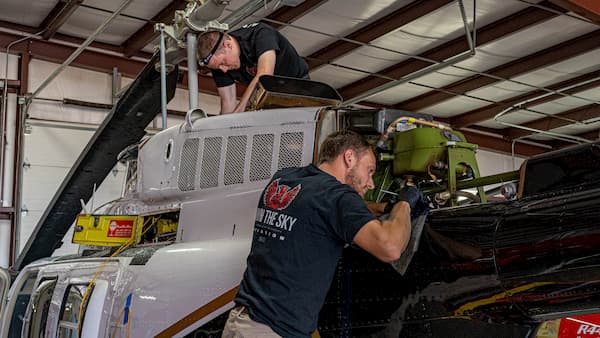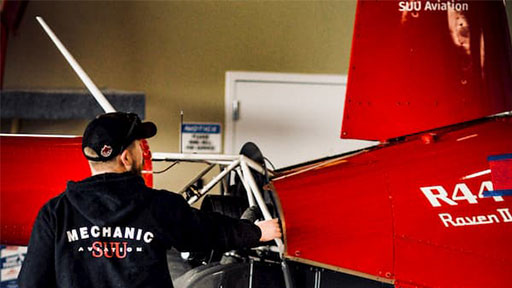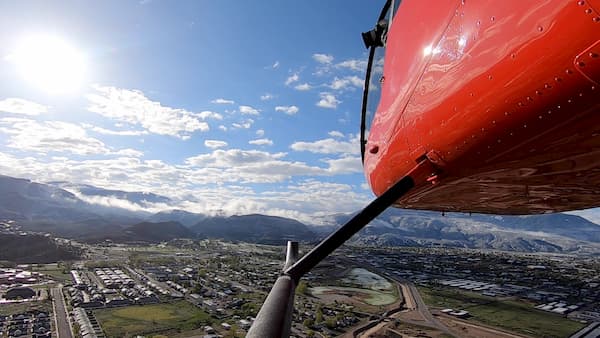How to Choose the Right Flight School
Posted: February 16, 2021 | Author: Jaidyn Crookston | Read Time: 18 minutes
Once you’ve decided to pursue your dream of becoming a pilot, it’s time to choose a flight school. This can be a difficult decision, especially because there are so many options all around the country. It’s important to choose the flight school that’s right for you, and many future pilots struggle to decide which school that is.
The first thing you need to know is that every flight school has good qualities. It’s deciding which flight school is BEST for you that may be tricky. Because there are so many options, look for several flight schools that you think may be a good fit, and then research them.
It’s important to research several flight schools before making a decision about where to train. Research will not only help you decide what you want out of a flight school and what aspects of a program are good for you, it will also help you learn what you don’t want from a flight school and what parts of a program you would rather avoid.
There are many ways to research a flight school. You can visit their website, read online reviews, look at Facebook and Instagram pages, and talk to friends, family, or acquaintances who’ve had experience with that particular school.
While you’re researching flight schools, there are some important questions to ask and find answers to. The answers to these questions will help you decide whether or not that flight school is right for you. If you look online and on social media and can’t find the answers to some of these questions, you can contact the school directly and ask for more information.
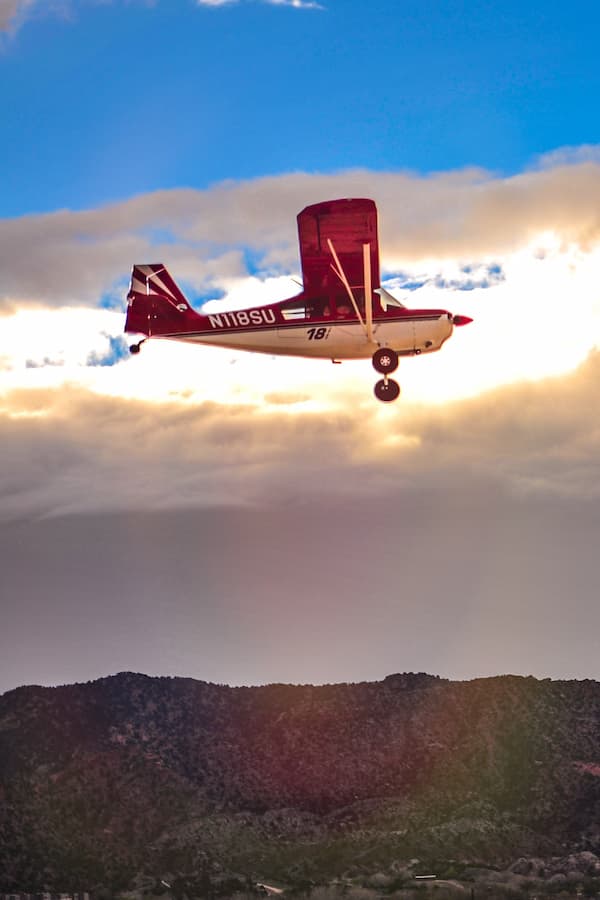 Questions to Ask Each Flight School
Questions to Ask Each Flight School
- Where is the school located?
- How long does it take to complete the program?
- How much does the program cost?
- What will you get for the cost?
- What licenses will you have at the end of the program?
- Will you be prepared to get a job right out of school?
- What is the job placement rate?
- Is the flight school attached to a university or not?
- Will you get a degree with your pilot’s license?
- Does the school train primarily helicopter pilots or airplane pilots?
- Is helicopter training a priority?
- How many aircraft does the school have?
- Does the school offer advanced training? And if so, is this advanced training only at an additional cost?
- What kind of aircraft do students learn to fly?
- How many flight hours will you have when you graduate?
- Does the school follow all FAA regulations?
- Does the school have industry connections and do these connections directly benefit the students?
- What are current and former students saying about the school?
By finding answers to each of these questions, you’ll be prepared to make a choice and decide where you want to train. Hopefully, one of the schools you research will stand out over all the others and your choice will be easy. If this doesn’t happen, then I would recommend visiting each school and going on a tour or an intro flight. This may not be possible if you live far away from the flight school, but you should definitely try to make it work. Once you’ve visited each school, I’m guessing there will be one that you like more than the others, and your decision will be made.
Each of the questions mentioned above are important when choosing a flight school. While it’s important to know what questions to ask, it’s also important to know why the answers to these questions can help you make a decision. Here’s why these are great questions to ask:
Where is the flight school located?
Moving somewhere new to attend flight training can be hard. If you’re a new student fresh out of high school, moving to a new place can be a great experience. If you’re a veteran or someone getting into flight training after a different career, moving can be tough. You may have a family to think about or you may be settled in wherever you are in the country.
Chances are that the flight school you choose won’t be close to where you currently live. If there’s a flight school nearby, then definitely check it out and see if it’s the one for you. However, there are so many other flight schools to consider, so don’t let the idea of moving stop you from following your dream and choosing the right flight school.
Moving to wherever a flight school is located probably won’t be permanent. You’ll most likely live in that area until you’re finished with your training and then you’ll move somewhere else to start your career. Unless you decide to become a flight instructor right out of training (and many students do) or there is a tour company nearby hiring pilots, then you’re going to end up moving somewhere new.
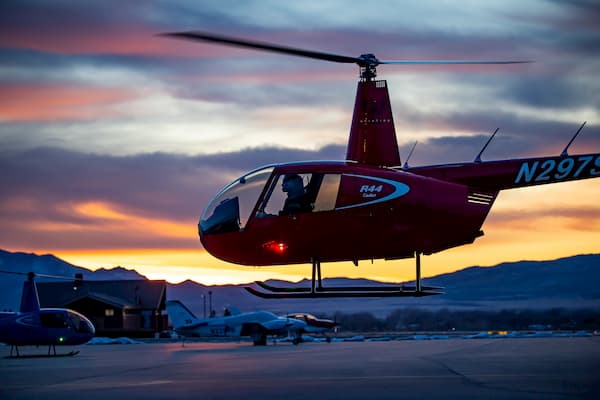
Knowing exactly where each flight school is located will help you plan finances and find housing. You’ll also be able to gauge if a flight school is in an ideal flight training spot. For example, Southern Utah University Aviation is the highest altitude collegiate flight school in the nation. Training to fly at a high altitude is extremely beneficial to pilots, especially helicopter pilots. The higher in the sky you’re flying, the more difficult it is to handle an aircraft. Training to fly at a high altitude will prepare you to fly anywhere in the world and will make flying aircraft easier in the future when faced with altitude changes.
There are other flight schools in ideal training spots as well for different reasons. It’s important to find out if a flight school has any benefits due to its location, so make sure to ask.
How long does it take to complete the program?
It’s also important to know how long a program will take to complete. Flight programs can range from a few months to a few years. Keep in mind that if you choose a flight program that only takes a few months, you won’t get all the benefits of a longer program. Longer programs will give you more flight hours, more experience, and probably more advanced training. In short, going to a longer flight program will better prepare you to get a job after earning your license.
I’d say that an ideal program would take between one and two years to complete. Attending a program this length will teach you everything you need to know about being a pilot and give you plenty of experience, and still be short enough for you to start earning money quickly.
How much does the program cost?
This is kind of a loaded question. Many flight schools will dance around this topic and it may be difficult to get a straight answer. There are many factors that go into determining the cost of a program, and even flight schools that strive to be transparent find it hard to give potential students a straight answer.
As a flight student, you’ll probably be charged by either the hour or by the semester. Flight schools that aren’t attached to a university tend to charge students by the hour. Students will be charged for instructor time, fees, and aircraft fuel, as well as any other costs the school has. Flight schools that are attached to a university will charge students by the semester. Here, instructor fees, fuel, and all other costs are typically included as an overall price for the semester and won’t change once the semester has started.
Due to how many other benefits university flight schools have, you’ll most likely get more for your money if you attend a flight school that’s attached to a university. One of the greatest advantages to training at a university flight school is that you’ll have access to federal financial aid and more scholarships than you will otherwise. Paying for flight school sounds scary to a lot of students, but it doesn’t have to be, especially if you qualify for financial aid.
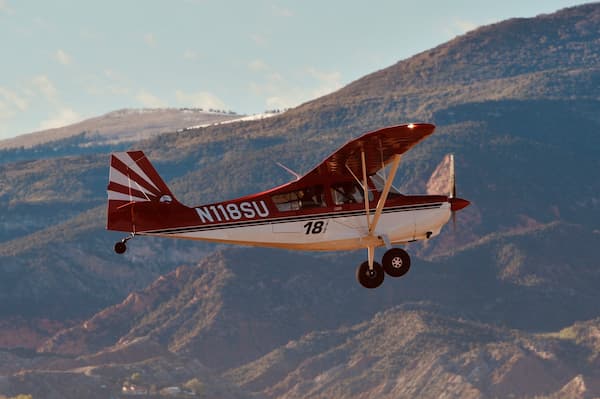
What will you get for the cost?
What you’ll get from your flight training depends on the individual school. Some flight schools offer advanced training, degrees, extra flight hours, and more for the cost of the program. At the very least, you need to make sure that you attend a program that will get you all the licenses you need to work as a pilot. If your goal is simply to fly an airplane or helicopter for fun, then all you’ll need is your private pilot’s license.
You need to know what’s covered by your fees and/or tuition. Find out if your instructor time, simulator time, flight time, and fuel are included in the cost or if you’ll be charged extra. You should also find out if your training will get you CFI and CFII licenses. Many schools skip over what is included in their prices, so finding out as much as you can beforehand will help you save money and choose a good flight school.
What licenses will you have at the end of the program?
Obviously, you want to attend a program that will give you the licenses you need to fly aircraft. There are several licenses you can earn as a pilot. What licenses you need to get depends on what you want to do as a pilot. The licenses you can earn are:
- Private pilot’s license
- Commercial pilot’s license
- Instrument rating
- Certified Flight Instructor (CFI) license
- Certified Flight Instructor Instrument (CFII) license
If you just want to own and/or fly aircraft for fun, then all you’ll need is a private pilot’s license. If you want to work as a pilot you’ll need a private license, commercial license, and instrument rating. If you want to work as an instructor (which is a common first job for pilots), you’ll need all of these plus a CFI license and a CFII license.
Before choosing a program, decide what it is you want to do as a pilot. Make sure to find a flight school that will give you all the training and licenses needed to do what you want.
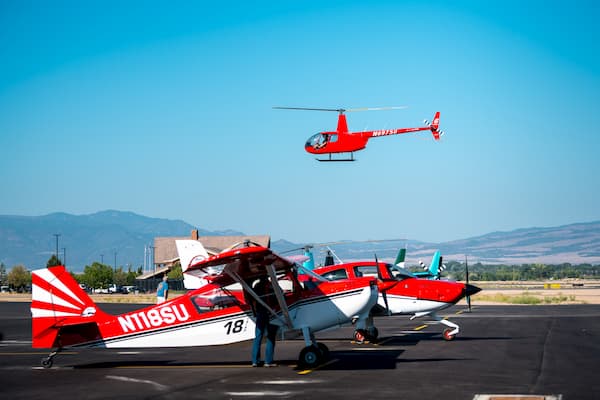
Will you be prepared to get a job right out of flight school?
You’re probably going to flight school so that you can get a job as a pilot. That means you need to attend a flight school that will fully prepare and qualify you for a job. There are several things a future employer will be looking for on your resume, including flight hours, advanced training, licenses, and references.
If you take the time now to think about what you want to include on your resume and what will impress a potential employer, you’ll be better prepared to finish your training near the top of your class and boost your chances of getting a job right out of flight school.
It’s important to choose a flight school that will help you get the experience, training, and flight hours you’ll need to get a job as a pilot.
What is the job placement rate?
It’s also a great idea to ask about the school’s job placement rate. The job placement rate of a school is basically just the percent of students that graduate who are able to get a job right out of school. This is a great number to know, because if a flight school has a high job placement rate, then clearly they’re doing something right and are properly preparing their students for a career after graduation.
Is the flight school attached to a university or not?
There are basically two kinds of flight schools: ones that are attached to a university and ones that aren’t. While neither of these kinds are necessarily better than the other, each has its own unique benefits and advantages over the other.
University flight schools have many benefits that outweigh the benefits, and costs, of a non-university flight school. The benefits of a university flight school include longer training, advanced training, more flight hours, paying by the semester, and more resources.
To learn more about the advantages of training at a university flight school, read this article.
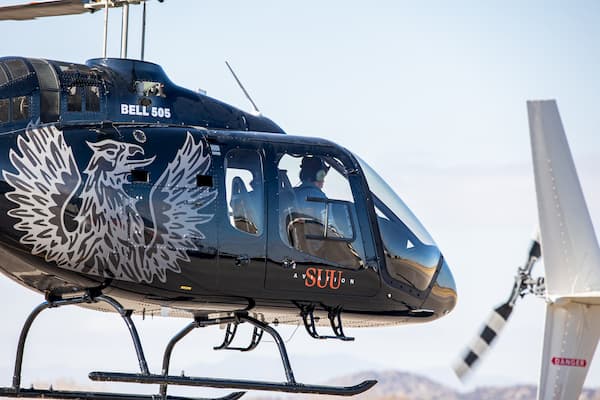
Will you get a degree with your pilot’s license?
If you want a degree with your license, you’ll need to go to a university flight school. Having a degree isn’t required to work as a pilot, but there are many benefits to having one. Getting a degree will take longer than other programs, so you’ll have more flight hours, advanced training, and experience. These are some of the biggest things a potential employer will be looking for, so building each of this is extremely beneficial. Getting a degree may also help you get higher-paying jobs and prepare you for a management position in the future.
Depending on the flight school you attend, you may be able to get an associate’s, bachelor’s, or even a master’s degree. SUU Aviation is one of the only flight schools that offers a master’s degree with a flight emphasis, so if it’s your dream to get a master’s degree and be a pilot, keep this in mind.
Does the school train primarily helicopter pilots or airplane pilots?
If you want to be a helicopter pilot, you need to find a flight school that has a good helicopter program. Most flight schools train primarily airplane pilots, which is great if you want to fly airplanes, but not so great if you want to fly helicopters.
Many flight schools offer helicopter training at an additional cost, but these extra programs aren’t as well funded or developed as their airplane training counterparts. If you want to be a helicopter pilot, it’s important to find a program that is well funded, well developed, and well respected. This will prepare you to enter the workforce much better than other helicopter programs will.
If you don’t know yet which kind of aircraft you want to fly, take a look at this article.
Is helicopter training a priority?
This goes along with the last question. If you want to be a helicopter pilot, you need to find a program that makes helicopter training a priority. This can be more difficult than it sounds. Most schools focus on airplane pilot training and may offer helicopter training at an additional cost.
Southern Utah University Aviation focuses on helicopter pilot training and takes great pride in this program. In fact, SUU Aviation has been ranked as the best collegiate helicopter pilot training program in the country.
How many aircraft does the school have?
How many aircraft a school has is more important than it may sound. This is especially true depending on how many students the school has. The more students the school has, the more aircraft the school will need to allow everyone time to fly and train. Since only one student can be trained in a helicopter or airplane at a time, it’s important that the school has enough aircraft to train all the students without long wait times. Schools also need to plan for maintenance disruptions and other delays.
SUU Aviation currently has 16 airplanes and 22 helicopters, one of the largest single-location helicopter fleets of any university. Having so many aircraft ensures that students are able to train at their appointed times and maintenance issues don’t disrupt the flow of training too much.
Does the school offer advanced training? And if so, is this advanced training only at an additional cost?
The more advanced training you have, the more prepared you’ll be to get a job and work as a pilot. Some kinds of advanced training that may be offered at a flight school include turbine transition, night vision goggles, external load, and mountain operations.
While it’s important to get advanced training, it’s also important not to overpay for this training. Many flight schools, especially university ones, offer this training as part of the curriculum at no additional cost. Finding a flight school like this is your best option.
What kind of aircraft do students learn to fly?
It’s also important to know what kind of aircraft students learn to fly. There are many different kinds of aircraft, and some are better for training than others. Factors that may make an aircraft better for training include cost to fly, safety, size, and specifications.
For example, one of the best airplanes to use during training is the Cirrus SR20 because this is one of the safest aircraft to train on in the world. One of the main reasons this is the safest airplane to train on is because the Cirrus SR20 has a parachute attached to the entire plane. While these parachutes are rarely needed, this extra safety factor is great to have during training.
How many flight hours will you have when you graduate?
Building flight hours is one of the most important things a pilot-in-training or a newly licensed pilot can do. In the aviation world, flight hours are often what determines which jobs you’ll qualify for. The problem with getting a job as a pilot is that in order to get a high paying job, you need to have a lot of flight hours.
By the time you get your pilot’s licenses, you’ll probably only have 100-200 flight hours. While you’ll only need about 200 flight hours to get your first job, you’ll need at least 1,000 flight hours to get a high paying job as a pilot. Obviously, there’s a problem here.
There are only a few jobs that will accept pilots with less than several hundred flight hours. For helicopter pilots, your options are to work as a tour pilot and to work as a flight instructor. For airplane pilots, your options are to work as a tour pilot, a flight instructor, banner tow pilot, glider tow pilot, or skydive jump pilot. There are probably other options as well, but these are the ones I’m aware of.
Your goal should be to get as many flight hours as you can during flight school, and then get a job that will allow you to build your flight hours quickly. The quicker you get to 1,000 flight hours, the sooner you’ll be making good money as a pilot.
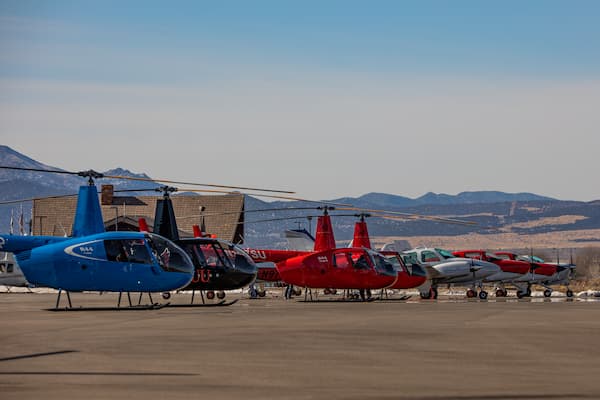
Does the school follow all FAA regulations?
The Federal Aviation Administration (FAA) has lots of rules and regulations that all flight schools need to follow. If a flight school doesn’t follow these regulations, it runs the risk of being shut down or being placed on probation. It’s a good idea to look into the history of a flight school to ensure that there are no red flags that may suggest a future problem with the FAA. Keep in mind, though, that some flight schools may have had problems with the FAA in the past and then come under new management. These problems may now be resolved and there may not be any future problems. It’s impossible to know for sure whether the FAA will have a problem with a flight school in the future, so just be aware of the possibility and make an informed decision while keeping this in mind.
Does the school have industry connections and do these connections directly benefit the students?
Many flight schools work very hard to build and keep connections in the aviation industry. Whether this is between other flight schools, aircraft companies, tour companies, or scholarship committees, these connections are important to growing and maintaining a flight school. You should find out which companies a flight school has connections with, and determine whether that connection can benefit you directly as a student.
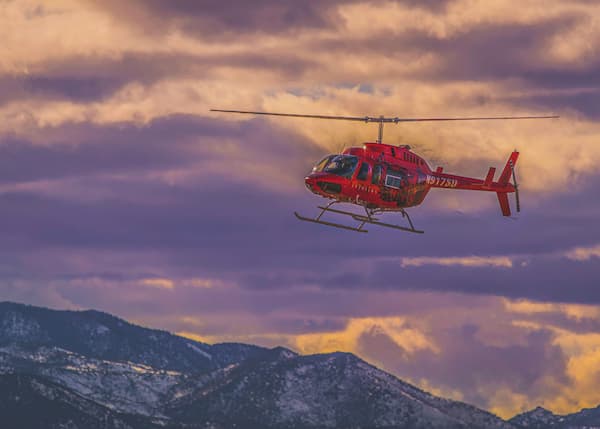
What are current and former students saying about the school?
Finding out what current and former students have to say about their flight school is a great way to learn about a school and decide whether it would be a good fit for you. You can find out what students have to say by asking on social media, going to the school and speaking with students, or by looking at online reviews. You can ask students whether the school really provides everything promised, how the instructors treat students, how many resources are available, and more.
After asking the flight schools you’re looking into each of these questions, you’ll probably find a clear winner and know which flight school is right for you. If there isn’t a clear winner or you still can’t decide, visiting each school personally for a tour or an intro flight is a great option. Actually visiting a school will help you see what it’s like and get a feel for how it would be to train there. Once you’ve visited each school, most likely there will be one that you like more than the others, and your decision will be made.
Once you’ve chosen and been accepted to a flight school, read this article to find out what your next steps should be. This article is aimed towards students coming to SUU Aviation, but the advice is the same for wherever you decide to train.
If you have any questions about how to choose the right flight school or to learn more about SUU Aviation’s flight programs, you can contact SUU Aviation or come in for a tour. If you decide that this is the right flight school for you, then congratulations and welcome to the family!
Produced by SUU Aviation
The university's fleet includes 16 airplanes, 23 helicopters by the end of 2020, and state-of-the-art maintenance training facilities. SUU Aviation offers advanced and relevant flight training in the safest and most efficient way possible. The program continues to be on the cutting edge of the industry, training tomorrow's aviation leaders. With SUU Aviation, you’ll get a high-quality education and have the experience needed to get a job as a mechanic when you graduate.
This article was published more than 3 years ago and might contain outdated information or broken links. As a result, its accuracy cannot be guaranteed.
Tags: Aviation


